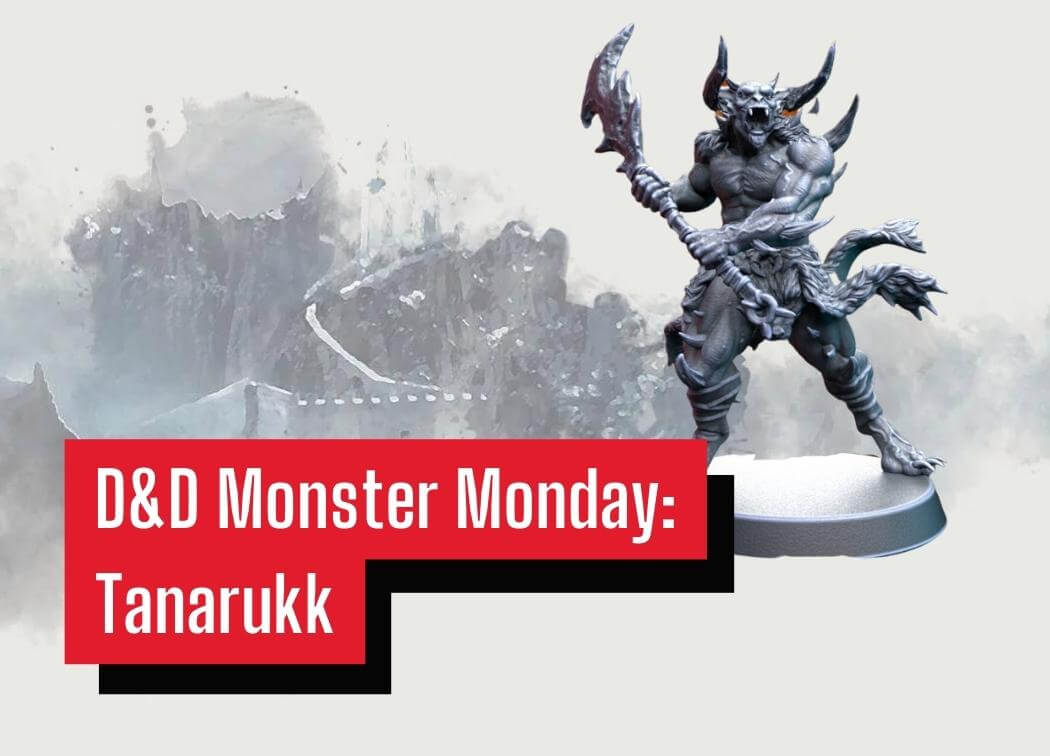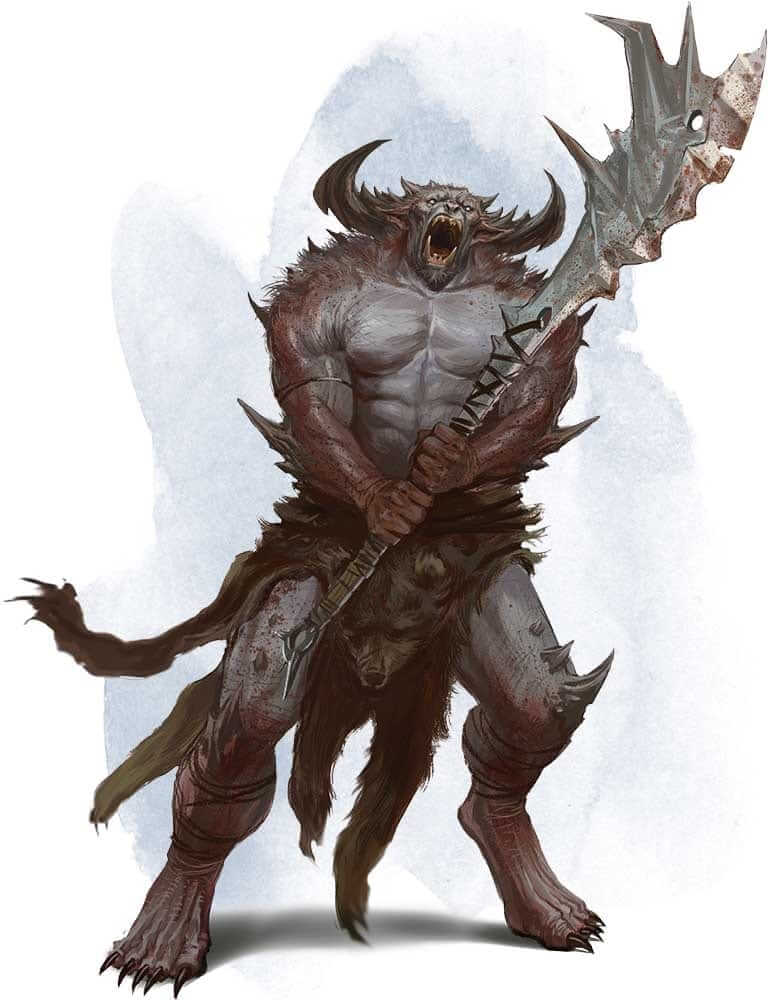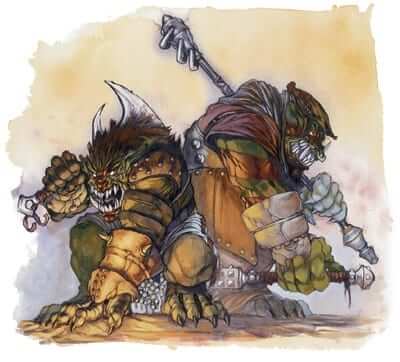D&D Monster Monday: Tanarukk

You hastily cast a spell on the demon-orc charging towards you. It laughs and barrels towards you even faster. The spell did nothing. You pray to your gods that your death is swift as it bares its greatsword down upon you.
For this week I wanted to take a look at one of the 6 variant orc creatures in Volo’s Guide to Monsters. I’ve used most of them in my games and I find them all to be really unique and flavorful creatures. The tanarukk is my personal favorite out of the 6 due to its play-style and lore.
Tanarukks love to be up close and personal with their target. They have a hefty amount of health and some solid resistances that keep them in the fight for quite some time. They are also very mobile and make it a point to blast through the party’s front-line and try to cleave the casters hiding in the back.
At first glance, its role is a bit similar to the minotaur, However, it has a few key abilities and traits that give it a different niche in the same tanky/bruiser melee role. Let’s dive into my favorite part of the tanarukk’s entry in VGtM, the lore.
Tanarukk Lore
Tanarukks are beings that are a combination of demon and orc. They are a consequence of an orc tribe being influenced or tainted by demons or demonic powers. The curse manifests as a mutation that transforms an unborn orc into a demonic creature. This creature, a tanarukk, is much stronger and more powerful than an orc, but they are also completely unhinged and savage.
Even an orc tribe can’t tame a tanarukk. Frequently these cursed orcs are killed at birth to prevent them from destroying the tribe. However, some clans leave them alive. They are completely powerless to control the tanarukks in their tribe, but they are unbelievable warriors. They may slay their own kind, but in a skirmish between two orc tribes, the side with the tanarukks will win handedly.
To make things worse, Baphomet continues to share the secrets to turning unborn orcs into tanarukks with his followers. If left unchecked, tanarukk, are also able to breed and will continue to produce tanarukk.
Tanarukk’s Stats and Abilities
You can find the full statblock for the tanarukk on page 186 of VGtM.
Base Stats
- Size: Medium
- AC:14
- HP: 95 (10d8+50)
- Speed: 30 ft.
- STR: 18 (+4)
- DEX: 13 (+1)
- CON: 20 (+5)
- INT: 9 (-1)
- WIS: 9 (-1)
- CHA: 9 (-1)
The tanarukk’s physical stats are excellent overall. It has a massive health pool with amazing strength and constitution. However, it severely lacks in intelligence, wisdom, and charisma. At face value it is a physical powerhouse, but it seems susceptible to CC with its low mental skills and only a +1 in dexterity. Couple this with a low AC for a CR 5 creature and you have yourself a creature with a pretty glaring weakness.

Resistances, Immunities, Saves, and Skills
- Skills: Intimidation +2, Perception +2
- Damage Resistances:fire, poison
- Senses: darkvision 60 ft., passive Perception 12
- Languages: Abyssal, Common, Orc
- CR: 5
Having resistance to both fire and poison damage is a pretty significant bonus. These are two of the most common damage types in the game. This definitely helps to make up for its low HP and low ability to pass saving throws on spells like Fireball. Darkvision is always a plus and it has some bonuses in perception and intimidation to make up for its low charisma and wisdom.
Abilities and Traits
Aggressive. As a bonus action, the tanarukk can move up to its speed toward a hostile creature that it can see.
Magic Resistance. The tanarukk has advantage on saving throws against spells and other magical effects.
Aggressive is an excellent ability as it allows the tanarukk to get 30 ft. of movement towards its target for free. Couple this with Magic Resistance and you have a creature that is hard to CC and has the ability to quickly close the gap between it and the party’s magic users.
Actions
Multiattack. The tanarukk makes two attacks: one with its bite and one with its greatsword.
Bite. Melee Weapon Attack: +7 to hit, reach 5 ft., one target. Hit 8 (1d8 + 4) piercing damage.
Greatsword. Melee Weapon Attack: +7 to hit, reach 5 ft., one target. Hit 12 (2d6 + 4) slashing damage.
These are pretty standard attack options. Neither of them are too fancy or very unique. If anything, I would say they are on the weaker side.
Reactions
Unbridled Fury. In response to being hit by a melee attack, the tanarukk can make one melee weapon attack with advantage against the attacker.
I love this ability. Unbridled Fury gives the tanarukk a way to always get 3 attacks in a single round of combat. It gets 2 attacks from its multiattack and will get 1 more at advantage if it is struck by a melee attack, or if a creature provokes an opportunity attack out of it. It also gives the tanarukk the ability to get a swing on the front-line at advantage if they make an attack of opportunity against it while it charges past them.
This is basically why the tanarukk’s attack actions are pretty weak. It will almost always be able to get 3 attacks (one of which potentially being at advantage) each round of combat. With this in mind its actions are balanced accordingly.
Tanarukk’s Strengths
Offensive Mobility
The tanarukk’s 30 ft. of movement isn’t impressive. However, its Aggressive ability gives it an extra 30 ft. when moving towards a hostile creature it can see. This only uses a bonus action and is the tanarukk’s only possible bonus action, so effectively it will always have at least 60 ft. of movement when chasing down an enemy.
It also doesn’t have to spend extra movement avoiding the party’s front-line melee character’s attack of opportunity. In fact, it relishes this due to its Unbridled Fury reaction. If the tanarukk is hit while it blows past the melee characters it will swing at them with advantage as it continues towards their squishy back-line characters.
Powerful Resistances
While the tanarukk only has 2 resistances, it has arguably 2 of the best resistances in D&D 5e. Poison and fire damage is pretty common in spells and magical weapons. It’s better to have these two resistances than a string of less common ones in my opinion.
Having advantage on saving throws and magical effects is huge. Even more so for a creature with low stats used for saving throws. Despite only having +1 to dodge a Fireball the tanarukk still has advantage on the saving throw and then resistance to its damage. Any sort of magical CC is going to be hard to pull of and maintain as it would still have advantage on the subsequent saving throws after the spell takes effect.
Between poison and fire damage resistance and its magic resistance trait the tanarukk has some pretty solid defenses in spite of its low AC.

Tanarukk’s Weaknesses
No Ranged Option
While it is mobile and resilient, the tanarukk will still have to force its way into melee range to deal any damage. It has no other option other than to burn its movement towards the easiest or closest thing it can deal some damage to. Not only this, but its Unbridled Fury requires it to be hit by a melee attack. The creature thrives in melee combat, but as the party finds a way to kite it about the battlefield it has no other options.
Its Aggressive ability does help combat this weakness, but if the party can find a way to slow the tanarukk or blind it this ability becomes increasingly useless. It needs to get within melee range of its target or choose a closer target, otherwise it will be useless in combat.
Easy to Hit
While it’s not easy to CC or even grapple, the tanarukk is easy to hit for a CR 5 creature. It does have a pretty large health pool to make up for this, but that only makes up for so much. Even if the tanarukk is rampaging through the party, they will eventually be able to whittle it down. Conversely, a large amount of burst damage from the party is also enough to drop this creature quickly as long as it isn’t primarily fire or poison damage.
Couple this with its lack of ranged options and you have a creature that is forced to be within melee range, is strong in melee combat, but is able to be chopped down to size if the party can survive its assault.
How to Play a Tanarukk
Death to Casters
Your tanarukk’s number 1 priority should be to find the lowest AC target and charge straight for them. They need to reach their target in time to get their 2-3 attacks off on it and then stick on the target. Whenever the target moves, use every inch of movement to catch right back up to it. Force the party to protect their low AC ally.
Even though it has magic resistance, the tanarukk should still be focused on downing magic-users first and foremost. It does not want to risk being dealt large amounts of damage, being crowd controlled, or letting them buff or heal their allies. Its magic resistance is the perfect trait to give the tanarukk an edge at being a mage-slayer.
If it is able to do this it can most-likely drop a caster in 1 or 2 rounds if it lands its attacks properly.
High Risk, High Reward
When you play a tanarukk against your party you need to go all-in. As we’ve established the creature has no other option but to use Aggressive to rush into melee range and start swinging. Provoke the party’s melee characters to attack you so that you can use your Unbridled Fury and make an extra attack at them with advantage.
Ideally, you’ll want to continue charging towards a caster or low AC target, but whatever you do you need to make your attacks every single round. The longer you allow the party to damage the tanarukk, the more likely it is going to drop before becoming a threat.
Get into melee range and deal as much damage as you can. Focus on dropping one of the PCs and then move on to the next one. The tanarukk is a master at single-combat, but that’s pretty much it.
Conclusions
The tanarukk is an interesting take on the traditional D&D orcs. I love them because they are powerhouses that require you to play extremely risky. I’ve thrown them at my party before and wreaked some serious havoc on them.
They have some cool lore that ties into Bahamut and the demon lords which is always a plus for campaigns that feature demons heavily. The lore also gives us a bit of an interesting take on orc tribes. What happens to a tribe that doesn’t kill their tanarukk? They know the risks of it one day massacring the whole tribe, but they’ve deemed it a worthwhile risk due to its ferocity against their enemies. This could be a pretty fun plot hook!
They make a great mage-slayer or even an excellent low-level boss encounter due to its Unbridled Fury giving it a pseudo-legendary action. While they’re not particularly versatile creatures, they’re definitely interesting and have a pretty fun niche to play in combat.

It seems like they would also be great supporters for something really nasty, like a demon or a powerful mage. They’d be sort of a different take on front-line defenses, less blocking the enemy and more forcing them to deal with the immediate threat and leave the caster to make trouble.
For sure. I used two of them as bodyguards for a caster recently and they caused some havoc in the backline to say the least!